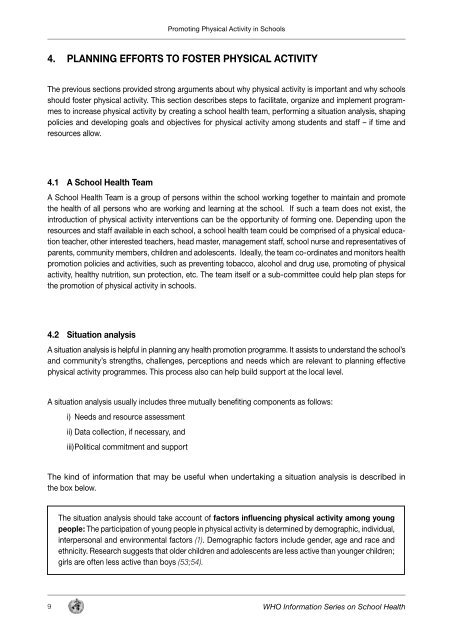WHO INFORMATION SERIES ON SCHOOL HEALTH ... - PAHO/WHO
WHO INFORMATION SERIES ON SCHOOL HEALTH ... - PAHO/WHO
WHO INFORMATION SERIES ON SCHOOL HEALTH ... - PAHO/WHO
You also want an ePaper? Increase the reach of your titles
YUMPU automatically turns print PDFs into web optimized ePapers that Google loves.
9<br />
Promoting Physical Activity in Schools<br />
4. PLANNING EFFORTS TO FOSTER PHYSICAL ACTIVITY<br />
The previous sections provided strong arguments about why physical activity is important and why schools<br />
should foster physical activity. This section describes steps to facilitate, organize and implement programmes<br />
to increase physical activity by creating a school health team, performing a situation analysis, shaping<br />
policies and developing goals and objectives for physical activity among students and staff – if time and<br />
resources allow.<br />
4.1 A School Health Team<br />
A School Health Team is a group of persons within the school working together to maintain and promote<br />
the health of all persons who are working and learning at the school. If such a team does not exist, the<br />
introduction of physical activity interventions can be the opportunity of forming one. Depending upon the<br />
resources and staff available in each school, a school health team could be comprised of a physical education<br />
teacher, other interested teachers, head master, management staff, school nurse and representatives of<br />
parents, community members, children and adolescents. Ideally, the team co-ordinates and monitors health<br />
promotion policies and activities, such as preventing tobacco, alcohol and drug use, promoting of physical<br />
activity, healthy nutrition, sun protection, etc. The team itself or a sub-committee could help plan steps for<br />
the promotion of physical activity in schools.<br />
4.2 Situation analysis<br />
A situation analysis is helpful in planning any health promotion programme. It assists to understand the school’s<br />
and community’s strengths, challenges, perceptions and needs which are relevant to planning effective<br />
physical activity programmes. This process also can help build support at the local level.<br />
A situation analysis usually includes three mutually benefiting components as follows:<br />
i) Needs and resource assessment<br />
ii) Data collection, if necessary, and<br />
iii) Political commitment and support<br />
The kind of information that may be useful when undertaking a situation analysis is described in<br />
the box below.<br />
The situation analysis should take account of factors influencing physical activity among young<br />
people: The participation of young people in physical activity is determined by demographic, individual,<br />
interpersonal and environmental factors (1). Demographic factors include gender, age and race and<br />
ethnicity. Research suggests that older children and adolescents are less active than younger children;<br />
girls are often less active than boys (53;54).<br />
<strong>WHO</strong> Information Series on School Health

















